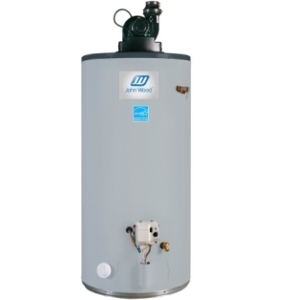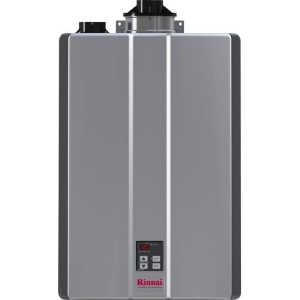John Wood
Gas Water Heaters
Review and Buying Tips
A review of the John Wood gas water heaters using different venting options: atmospheric, direct, power direct vent, power vent models, and ultra-efficient models such as the Envirosense and Polaris. Compare models and explore the main differences.

Highlights
- Atmospheric
- Power vent
- Power Direct vent
- Direct vent
- Envirosense Power Direct vent - high efficient
- Envirosense Power vent - high efficient
- Polaris - high efficient
Atmospheric vent (Energy Star and Standard)
Equipped with the FVIR Flame Guard Safety System, John Wood gas water heaters with the atmospheric vent reduces the risk of the accidental ignition of the flammable vapors outside the combustion chamber.
Only atmospheric vent models that utilize the flue damper are Energy Star compliant due to the increased energy efficiency and performance. These models also include the gas valve with the diagnostic capabilities that also monitor the flue damper's proper work.
They also contain the Turbulator system, a system with the advanced design of the dip tube to reduce the sediment build-up and prolong the heater's life and performance.
There are four models available in this group, two having the 40-gal and two with the 50-gal tank capacities, all with the energy factors of 0.67.
Atmospheric vent units are also available with the thermopile design built with the better quality pilot and gas valve, while the LED indicator helps in diagnostic and troubleshooting.
The group has more models to choose from, from 30 to 75-gal capacity, but the energy factor is lower than the previous group; it ranges from 0.58 to 0.60.
Power vent
John Wood gas water heaters with the power vent options are Energy Star models, designed with the tank capacities from 40-gal to 75 gallons and the energy factor of 0.70 or 0.68 on 75-gal models.
The power vent and its rotatable blower allow flexible venting installation. The water heaters can be vented either horizontally through the outside wall or vertically through the roof, which is not the case with the previous type. The advanced gas control valve features a self-diagnostic capability for convenient and easy troubleshooting.
All power vent models from John Wood include the Flammable Vapor Sensor and air intake snorkel as part of the FVIR system that prevents the ignition of the flammable vapors from gasoline, paint, and different solvents when are stored close to the water heater.
Power Direct vent - PDV
Power direct vent models utilize the electric blower and the sealed combustion for safe operation as the indoor air is untouched. As with the previous power vent models, PDV units also provide great flexibility during the installation with the long vent lengths and different materials used. Only two sizes, 40 and 50 gallons, are available, and both are high-efficient.
Direct vent
John Wood gas water heaters with direct venting use the Flame Safe technology designed to protect from the accidental ignition of flammable vapors. While most units have the standard piezo-pilot ignition, a direct vent water heater utilizes the thermopile design so the pilot can withstand different conditions and does not need electrical power to run.
Envirosense Power Direct vent
The Envirosense Power Direct Vent is an ultra-efficient water heater with 96% energy efficiency, mainly because of its design utilizes the spiral-shaped and condensing heat exchanger. The availability of the side connections makes the unit suitable for use in recirculating systems.
The advanced electronic control comes with a large LCD display where it shows the temperature and the error codes if the problem appears. As opposed to the above models, Envirosense uses two sacrificial rods for better protection against corrosion. There is only one model available, and it comes with the most popular tank size of 50 gallons.
Envirosense Power vent
Envirosense Power Vent group offers a 50-gal unit with slightly lower efficiency, 90%, but still considered as ultra-high. The difference between this model and the above unit can be seen in its Intelli-Vent gas control. The silicon nitride hot surface igniter is considered indestructible and lacks an LCD screen.
Both models have the same tank size, but the previous model has higher gas input, 100,000 vs. 76,000 BTU, and recovery rate, while the First Hour Rating is higher on the Envirosense Power Vent model. This model is available in natural gas only, while the above model uses natural gas and propane.
Polaris
Polaris is the ultra-efficient gas water heater that utilizes the submerged combustion chamber with the spiral flue and can provide 95-96% thermal efficiency. All the John Wood gas water heaters use the metal tank, but not Polaris, it is equipped with the stainless steel tank that provides years of service and eliminates the need for the sacrificial anode rod, so there is less maintenance involved.
The high-quality gas burner produces less NOx gases and is durable due to better resistance to stress. Polaris can be found in the capacity range from 34 to 50 gallons, all designed for potable water and space heating applications.
When you compare Polaris with the second-best models, the Envirosense, you will see that the power input on Polaris is much higher 130,000 vs. 100,000 BTU, including the recovery rate; 166 GPH vs. 129 GPH.
Related
Leave a Comment


